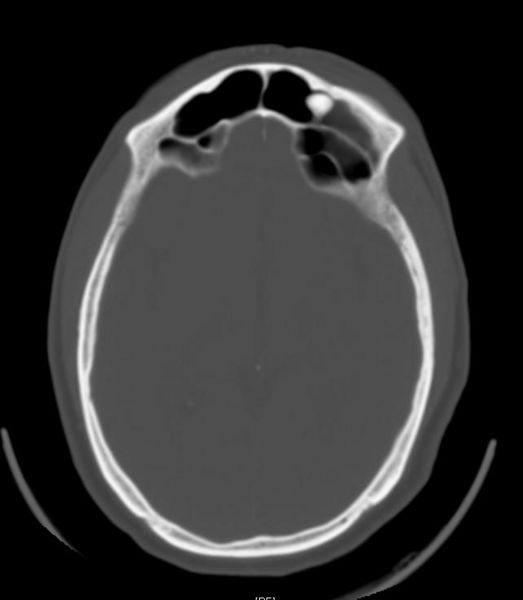Osteoma
|
Osteoma Microchapters |
|
Diagnosis |
|---|
|
Treatment |
|
Case Studies |
|
Osteoma On the Web |
|
American Roentgen Ray Society Images of Osteoma |
Editor-In-Chief: C. Michael Gibson, M.S., M.D. [1]
Synonyms and keywords: Osteoma; osteomata
Overview
An osteoma (plural: "osteomata") is a new piece of bone usually growing on another piece of bone, typically the skull. It is a benign tumor.
When the bone tumor grows on other bone it is known as "homoplastic osteoma"; when it grows on other tissue it is called "heteroplastic osteoma".
Diagnosis
Physical Examination
Ear Nose and Throat
-
Left Mastoid Osteoma. This patient presented with a slowly growing painless hard mass of the mastoid bone [1].
-
Axial CT scan of the temporal bones showing a left mastoid osteoma [2].
-
Surgical picture mastoid osteoma. The osteoma was exposed through a post-auricular incision and the periosteum was also incised and elevated [3].
-
Surgical picture mastoid osteoma. The osteoma was removed with the drill and the mastoid surface smoothed down. Note the yellow discoloration ring at the site of the excised osteoma [4].
CT
CT image demonstrates a left frontal sinus osteoma
Variants
- "Osteoma cutis" (also known as "Albright's hereditary osteodystrophy")
- "Osteoid osteoma": An osteoid osteoma is a small benign lesion that can occur in any bone of the body, but is most frequently found in the leg. Another common location is the spine, where the tumor may cause a painful type of scoliosis. Osteoid osteomas typically affect teenagers and young adults, and are more prevalent among males than females. The tumors produce excess bone and secrete pain-causing prostaglandins, resulting in intense pain that is especially pronounced at night, when it can awaken the patient from sleep. The pain is temporarily well-relieved by aspirin or ibuprofen, but surgical intervention is usually necessary for complete palliation. Some osteoid osteomas can be treated by a less-invasive procedure known as radiofrequency ablation, but this procedure is ill-suited for tumors in areas such as the hand or spine, as it involves heating the tumor to a high temperature that may cause damage to nerves in the surrounding area. Osteoid osteomas may spontaneously resolve without treatment, but there is currently no way of detecting if and when this is likely to occur.
- "Fibro-osteoma"
- "Chondro-osteoma"
See also
Acknowledgements
The content on this page was first contributed by: C. Michael Gibson, M.S., M.D.
Initial content for this page in some instances came from Wikipedia
![Left Mastoid Osteoma. This patient presented with a slowly growing painless hard mass of the mastoid bone [1].](/images/5/50/Mastoid_Osteoma_13April05.jpg)
![Axial CT scan of the temporal bones showing a left mastoid osteoma [2].](/images/5/5f/Mastoid_Osteoma_Labeled.jpg)
![Surgical picture mastoid osteoma. The osteoma was exposed through a post-auricular incision and the periosteum was also incised and elevated [3].](/images/b/b7/Mastoid_Osteoma_May_15_2005_480_SQ.jpg)
![Surgical picture mastoid osteoma. The osteoma was removed with the drill and the mastoid surface smoothed down. Note the yellow discoloration ring at the site of the excised osteoma [4].](/images/1/10/Mastoid_Osteoma_May_SQ_480_15_2005_001_7_.jpg)
